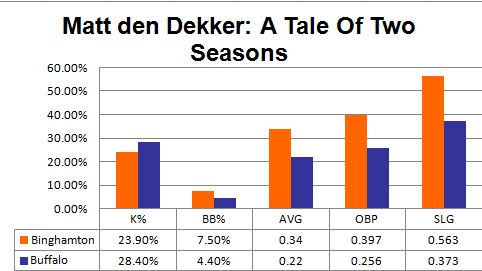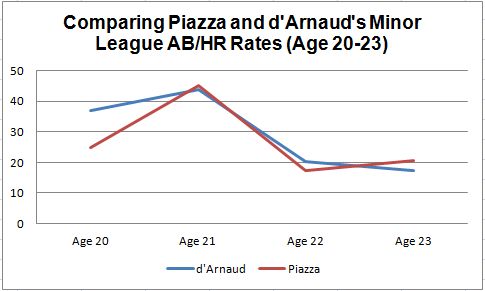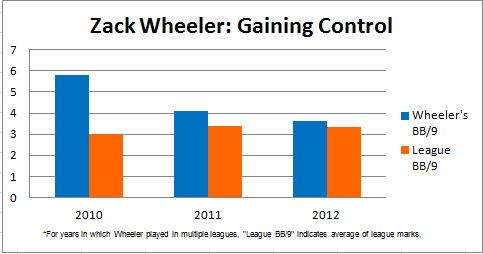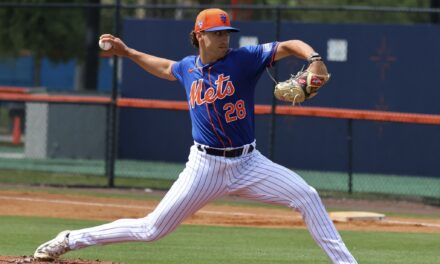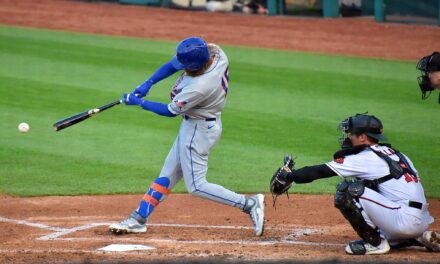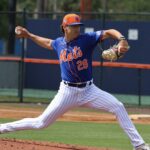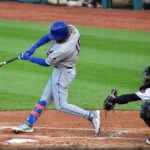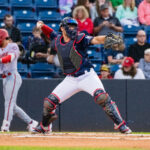After reading the wonderful prospects list that some of my fellow MMO writers put together, (which is incredibly well-done, well-researched and a must-read for prospect gurus), I decided to share my own prospect list, which I have been working on for a while, with you all.
In putting together this list, I tried to balance as best I could major league readiness with the so-called “ceiling” of each prospect. In compiling the list, I looked at and analyzed career statistics, video, scouting reports, and the opinions of some well-respected scouts and Mets minor league experts before coming to my conclusions. Enjoy!
20. Jack Leathersich, LHP
Height: 5’11”
Weight: 205
Throws/Bats: L/R

We may be seeing Josh Edgin 2.0 as Jack Leathersich shoots up the ladder. Another college lefty reliever. However, Leathersich is rather unconventional, and has been slightly more successful than Edgin was in his short time in the minors. Although he had a 4.12 ERA over the second half of the year when he was with St. Lucie, Leathersich had an astronomical strikeout rate of 14.2 batters per nine. That’s 35.5% of the hitters he faced.
There is still one question with Leathersich, a very important one. Is his success because of his talent or a deceptive delivery? Watch his delivery below and you’ll see what I’m talking about:
He struggled to get hitters out for the first time in his career with St. Lucie last year, and we’ll have to wait and see how his delivery translates to the higher levels.
2013 Outlook: Leathersich has been shooting up through the lower levels, and will likely continue to do so. He may even be an outside candidate to pitch for the Mets in the second half this year. Then, we’ll see what he’s got. He will start the year with Binghamton in all likelihood and go from there. If his success continues, he will move up fast.
19. Cory Vaughn, RF
Height: 6’3″
Weight: 225
Throws/Bats: R/R
A former fourth-round pick and son of former major leaguer Greg Vaughn, right fielder Cory Vaughn is a physically-gifted, all-around athlete. Coming out of San Diego State in 2010, Vaughn was projected as a five-tool player, and did a little bit of everything once he turned pro. In his first professional season with the Cyclones, he hit .307/.396/.577 with 14 home runs in just 72 games. He also swiped 12 bases and hit five triples.
In 2011, Vaughn saw his numbers drop. He had a decent first half with Savannah, batting .286 (although he hit only four home runs) until he was called up to St. Lucie, where he struggled even more. In an injury-riddled second half, Vaughn hit only .219 in 63 games.
2012 was another year of mixed results for the 23 year-old outfielder. Everything was there – the power, speed, defensive skills – except for the hit tool. Vaughn struggled to but the barrel on the ball consistently, hitting just .243. The key to Vaughn’s success going forward will be his ability to hit for average. The other tools are there, but the one he didn’’t show this year is the most important to future success.
2013 Outlook: Vaughn has played 189 games for St. Lucie, so but he may end up there again. He may start the season there again because of his struggles at the plate last season. He will be turning 24 in May, so the clock is ticking. We’ve seen what happens to guys like Zack Lutz and Josh Satin getting “stuck” in the minors because of age. Vaughn still has some time, but he can’t afford to spend the majority of 2013 in St. Lucie.
18. Phillip Evans, SS
Height: 5’10”
Weight: 185
Throws/Bats: R/R
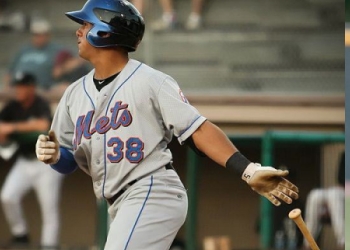
The Mets got a steal two years ago when, in the 15th round they drafted a high school shortstop named Phillip Evans. Evans was a 2nd-round talent, but scouts were scared off by his commitment to San Diego State. Luckily, the Mets were able to grab him late and sign him for $600,000.
Scouts say Evans has an advanced approached at the plate. He also generates a decent amount of power, despite being very small. (He is listed at 5’10”, but is much shorter). He hit .252 in his first full professional season with Brooklyn. He had an OPS of .665, but hit five home runs, third on the team.
The Mets will have to decide over the next few years where exactly Evans fits. He has a weak throwing arm and often has to take a few steps before making a throw to first. The general belief Is that he will eventually have to move to second base.
2013 Outlook: Phillips will probably split time with Savannah and St. Lucie this season.
17. Matt den Dekker, CF
Height: 6’1″
Weight: 205
Throws/Bats: L/L

It was like two separate seasons for Matt den Dekker in 2012. In the first half, we saw his bat come alive, as he hit double after double (along with a few home runs), batting .340 in 58 games for Double-A Binghamton. Den Dekker was arguably the best player in the league, socking 21 doubles, four triples, and eight home runs. He also stole ten bases and continued to play incredible defense.
The second half was a different story for den Dekker, after he was called up to Buffalo. He was striking out more, walking less, and most importantly, hitting the ball less. Here is how his first half in Binghamton compared to his time with Buffalo:
Den Dekker is facing the same strikeout problem that held Kirk Nieuwenhuis back last season. He has to lower his strikeout rate drastically or he is going to have a very difficult time hitting in the big leagues. You can’t get away with a 25% strikeout rate in the bigs. He’s too much of a free-swinger (as you can tell by his walk rate, which was already low in the first half) and big league pitching will test him.
2013 Outlook: Last year, den Dekker was a candidate to make the team out of Spring Training, but that’s not happening no matter how he performs in spring games. He will need to put together a few months with lower strikeout rates in order to get the promotion.
16. Gabriel Ynoa, RHP
Height: 6’2″
Weight: 158
Throws/Bats: R/R
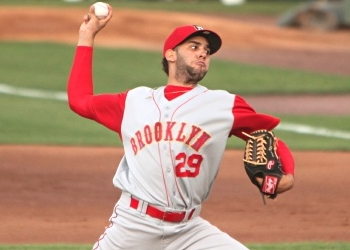
After dominating the Dominican Summer League two years ago and pitching well in the Gulf Coast league in 2011, Gabriel Ynoa once again had a fantastic season, this time as a part of Brooklyn’s incredible pitching rotation.
Ynoa showed ridiculous control, walking only 1.2 batters per nine innings. The skinny right-hander has always been known for his excellent command, and in over 200 pro innings, he has walked only 22 batters.
Ynoa made 13 starts in the New York-Penn League this season, and in 76.2 innings, he had just a 2.23 ERA. He also struck out 7.5 batters per nine, up from only 4.3 the year before. He has a good changeup and a low-90s fastball that he commands very well. Hopefully, he will fill in his 6’2” frame (he’s listed as only 158 pounds), which could help him put a little more heat on his fastball.
2013 Outlook: Ynoa is so young and still has to build up some innings. He will probably go to Savannah in the spring and stay there the entire season.
15. Wilfredo Tovar, SS
Height: 5’10”
Weight: 160
Throws/Bats: R/R
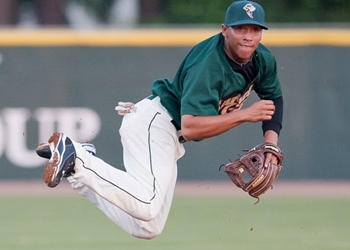
Tovar has always been known as a very skilled defensive shortstop. That’s his best skill, and he is probably the best defender in the entire Mets system. The questionable part of his game has always been his bat.
Signed out of Venezuela at 16 years old in 2008, Tovar had a tough time hitteing at even the lowest levels of the minor leagues, hitting just .203 in 49 games in the Venezuelan Summer League. He saw some improvement in the following years, as his batting average hovered around .250. Last season, he started to see some big changes.
After playing the better part of two years with Savannah, Tovar started the year with St. Lucie, and he started hitting the ball much better. In his 65 games with St. Lucie, he hit .284 with a career-high .377 on-base percentage and 11.3% walk rate, a significant improvement from the year before. He had a tough second half in Binghamton, with his numbers reverting back to what they were pre-St. Lucie, but that may have been due to the fact that he was 20 playing in Double-A.
Tovar certainly has the potential to be a Ruben Tejada-type player with an even better glove. We just have to wait and see how the bat develops. He started hitting some more extra-base hits this season, which was a very good sign. He will need that gap-to-gap power in order to become an MLB regular.
2013 Outlook: The Mets will be in no rush with Tovar. He will begin the season in Binghamton and play most of the season there.
14. Aderlin Rodriguez, 3B
Height: 6’3”
Weight: 210
Throws/Bats: R/R
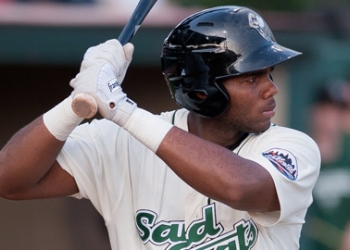
Possibly the best power hitter in the system, Rodriguez had a breakout campaign in 2012. The 21 year-old corner infielder, repeating low-A Savannah, displayed incredible power throughout the first half. He clubbed 16 home runs and slugged .497 in just 318 at-bats. This is in Savannah, where home runs go to die. Rodriguez has power to spare.
After 83 games in Savannah, Rodriguez finally made the trip to St. Lucie, where he would spend the rest of the season. There, he saw his batting average and walk rates plummet, but his power numbers stay well above-average. He finished his time in St. Lucie with a .190 ISO and eight home runs in 42 games.
Rodriguez’s power could take him a long way. He still doesn’t really have a defensive position. However, if Rodriguez can keep his power numbers up and improve his walk rate, it won’t matter what position he plays because his bat will make up for whatever he lacks defensively.
2013 Outlook: Rodriguez only played 42 games in St. Lucie, so he will probably play another half season or so before going to Binghamton.
13. Kevin Plawecki, C
Height: 6’2”
Weight: 205
Throws/Bats: R/R

The Mets used their supplemental round pick last year on a young catcher from Purdue named Kevin Plawecki. Scouts praised him for his refined approach at the plate and his ability to hit home runs. One year later, Plawecki is the second-best catching prospect in the farm system, behind only Travis d’Arnaud.
Plawecki signed early and played 61 games for the Brooklyn Cyclones, and showed off his power. He led the team in home runs with seven despite hitting only .250. His patience was also very impressive as he had a walk rate of 9.9%. Combine that with a fantastic 9.5% strikeout rate and you can see why the Mets drafted him so high.
On the downside, Plawecki hit only eight doubles last season, and will need to work on his gap-to-gap power. Also, while he threw out almost 50% of base stealers, he still has work to do defensively.
2013 Outlook: Plawecki is still a few years away. However, because of his patience at the plate, he will likely play most of the year in St. Lucie as opposed to Savannah.
12. Gavin Cecchini, SS
Height: 6’1”
Weight: 180
Throws/Bats: R/R
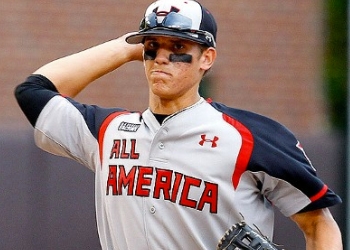
Gavin Cecchini is what scouts call a “baseball rat.” He comes from a baseball family. His father is the baseball coach at his former high school and a former college player. His brother Garin Cecchini is a speedy third baseman and one of the top prospects in the Red Sox organization. Gavin is a smart baseball player with great instincts. He doesn’t have the raw talent that some of his fellow 2012 draft picks have, but scouts say he has outstanding baseball instincts.
Cecchini signed very quickly, allowing him to get some experience in Kingsport to start of his career. His bat proved to be a work in progress as he hit only .240 and hit only one home run. However, his swing is smooth and he has the potential to be a very good line drive hitter. He doesn’t have the power, but that was never expected of him.
Cecchini’s defense is really why he was drafted. He doesn’t have particularly great speed or arm strength, but otherwise has the tools to be a good defender. As I mentioned, he has great baseball instinct which will help him read hitters and make him an even better defensive player at a position where that’s very important.
2013 Outlook: Cecchini is still a very raw talent, and will likely stay in St. Lucie for extended spring training before heading to Brooklyn. The Mets will take it slow with him and we probably will not see him until at least September 2015.
11. Jacob DeGrom, RHP
Height: 6’4”
Weight: 185
Throws/Bats: R/L
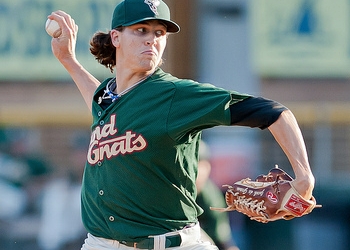
DeGrom had a stellar season for Savannah, surprising a lot of followers of Mets minor league baseball. Before the season started, he wasn’t very highly-rated and was outside of Toby Hyde’s top 41 list. The 24 year-old had surgery in the fall of 2010, just months after he had been made a 9th round pick by the Mets. He sat out the entire 2011 season rehabbing, and was able to start the season with Savannah.
Despite the serious injury, DeGrom came back with a vengeance, immediately dominating South Atlantic League hitters. He displayed excellent control, walking only 1.6 batters per nine innings, while striking out 7.8. He ended up making 15 starts with Savannah, tossing 89.2 innings with a 2.51 ERA along the way, before earning a late-season promotion to St. Lucie for the playoff run.
DeGrom made four starts to end the regular season in St. Lucie and an additional one in the playoffs, allowing just five runs in 27.2 High-A innings. DeGrom will need to develop his off-speed stuff in order to stay a starter, but is on track for a successful career. There is still a concern for his health after his Tommy John surgery, but after watching how he responded this season, that may not be a problem again.
2013 Outlook: DeGrom will likely pitch no more than a few months in St. Lucie, especially if he keeps pitching like he did last year. Expect him to debut sometime in late 2014 or 2015.
10. Luis Mateo, RHP
Height: 6’0”
Weight: 170
Throws/Bats: R/R
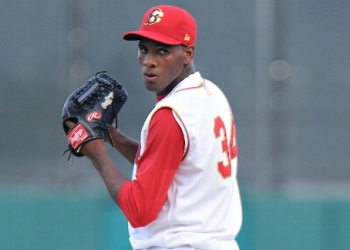
Mateo followed a long and unconventional path to get where he is today. He was originally signed by the Giants five years ago for $625,000, bone chips were found in his elbow, and the Giants voided his contract. Later that year, he signed with the Padres for $300,000, but after an MLB investigation, it was revealed that Mateo had lied about his age. He served a suspension, and finally signed with the Mets in 2011 for only $150,000.
Mateo dominated the Dominican Summer League in his first pro season in 2011, making 13 starts (63 innings) and posting a 2.00 ERA. He impressed the Mets front office enough to skip the Mets’ rookie affiliates and head straight to short-season Brooklyn, where he would become the face of a very formidable pitching staff.
Mateo used a combination of two dangerous fastballs and a sharp slider to dominate the league, posting a 2.45 ERA in 73.1 innings and even more impressively, a K/BB ratio of 9.44. In those 73.1 innings, he struck out 85, and walked nine. You can make an argument that this is the result of a 22 year-old in the low-A New York-Penn League, which is why he’s not ranked in the top five on this list. Had he been two or three years younger, I would put much more stock in the numbers he put up, but until I see him dominate in the Florida State League or Eastern League, that uncertainty remains.
2013 Outlook: As long as Mateo keeps pitching well, the Mets will keep promoting him. I wouldn’t be surprised if he only makes a few starts with Savannah, or skips Savannah entirely like he did Kingsport.
9. Rafael Montero, RHP
Height: 6’0”
Weight: 175
Throws/Bats: R/R
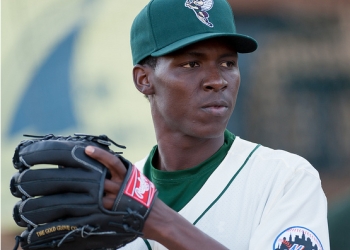
Rafael Montero transformed his reputation this year with a stellar season between Savannah and St. Lucie. Despite pitching 71 innings in 2011 with a 2.15 ERA between the Dominican Summer League, the Gulf Coast League, Kingsport, and Brooklyn, Montero wasn’t taken too seriously before the season started. In just a few short months, however, he became one of the highest-rated pitching prospects in the entire farm system.
Montero, 22, signed a little late in the game as a 20 year-old out of the Dominican Republic in 2011, but has rocketed through the Mets’ system. Boasting a low-90s fastball, a solid slider, and a changeup, Montero has excellent command, walking only 1.4 batters per nine innings last season while striking out 8.1.
Montero has a special combination of control and pure stuff. It’s still early, but I expect we’ll see great things from him. He is one of many promising young pitchers working their way through the lower minors that could definitely be in the Met rotation in a few years.
2013 Outlook: My guess is Montero will split the season between St. Lucie and Binghamton (If he continues to pitch well) much like how he split the season between Savannah and St. Lucie this year.
8. Domingo Tapia, RHP
Height: 6’4″
Weight: 186
Throws/Bats: R/R
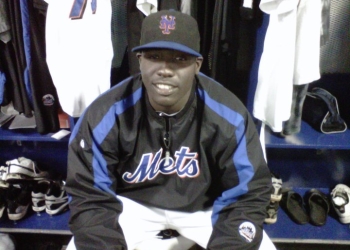
Domingo Tapia’s future role is still very much up in the air. Tapia, 21, had a breakout year last season with Savannah. Although his ERA (3.98) was slightly worse than his 2011 mark (3.38), he had a much better season. Tapia, whose repertoire consists of a high-90s two-seam sinking fastball, a high-90s four-seam fastball, a high-80s changeup, and a below-average breaking pitch, struck out 8.4 batters per nine, much better than his 5.8 mark in 2011. Despite having pitched just over 220 professional innings, Tapia already seems destined for the bullpen. He doesn’t have much of a breaking pitch, relying almost completely on his sinker and four-seam fastball. That combination has worked so far, but won’t work as he climbs the minor league ladder, especially as a starter. It may also be difficult for him to develop a breaking pitch considering how low his arm slot is. He is still very young, however, so there is still time for Tapia to develop a breaking pitch. Now the decision rests with the front office: to keep him a starter, they may have to raise his arm angle, possibly jeopardizing his sinker. The Mets will have to decide whether they will take that risk or move him to the bullpen.
2013 Outlook: The future is unclear in regards to Tapia. While scouts agree that he has a great sinker and a good four-seam, his role is still up in the air. As for this season, you’ll probably see him in St. Lucie.
7. Jeurys Familia, RHP
Height: 6’4″
Weight: 230
Throws/Bats: R/R
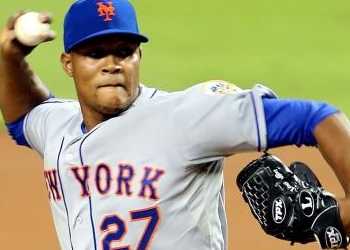
Last year was a bumpy one for Jeurys Familia. In 2011, it looked like he had finally started to put it together as a starter, pitching 23 games with a 2.90 ERA in 124 innings between St. Lucie and Binghamton. It looked like the mechanical issues were starting to get fixed and he was looking more and more like a starter. That changed this past season, as Familia regressed.
Familia was very inconsistent in his season with Buffalo. Every few starts, he would dominate and strike out seven or eight batters, but those starts were few and far between. For most of the season, Familia struggled with his control, worked up a high pitch count, and was unable to go deep into games. He has the stuff to be a good pitcher, but he doesn’t have the makeup of a starting pitcher.
Familia has what it takes to be a successful reliever, which is where I think he will eventually end up. The Mets will probably give him another year as a starter (unless they feel they really need him in the bullpen) to develop his breaking pitches. If he doesn’t stay a starter, the transition may take a few months but eventually, he could be the full-time closer and be a good one too.
2013 Outlook: A bullpen role seems most likely long-term unless Familia makes major improvements with his control and secondary pitches this year or in 2014. He will start the year in Triple-A and go from there.
6. Brandon Nimmo, OF
Height: 6’3″
Weight: 185
Throws/Bats: R/L
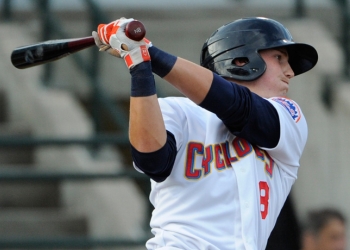
The Mets took a big risk in 2011 when they drafted 18 year-old outfielder Brandon Nimmo out of Wyoming. Why was it such a risk? There is no high school baseball in Wyoming, so the only experience Nimmo had was on top-tier club teams in his area. That, on top of an injury in high school that caused him to miss an entire season put him at a disadvantage when making the jump to professional baseball. This season, after playing only ten professional games in 2011, made the jump to Low-A Brooklyn in the tough New York-Penn League, where many of the top college picks are sent. After a full season there, the numbers don’t stand out as those of a future star, but considering his experience in high school, his season was impressive. He batted just .248, but had a very high walk rate of 14.3%. He also displayed some power, hitting six home runs in 266 at-bats. His ISO (Explanation) of .158 was ninth best in the New York-Penn League. Among players under 20 years of age (with a minimum of 200 Plate Appearances), he was first in that category. He finished tenth in the league in homers, and was the only player under 20 in the top ten. However, he didn’t show much speed or hit lefties very well. Nimmo is someone who is still very inexperienced, so fans have to be more patient than usual with him. The front office will surely take it slow with him, as he is still a very raw talent.
2013 Outlook: The Mets will take it slow with Nimmo this season. He will probably spend the entire year with Savannah. It’s still too early to get a real sense of what type of player Nimmo will be, but the signs so far point towards Nimmo eventually becoming an average to above average major league player at worst. But again, it’s too early to make any conclusions (as is the case with any of these prospects) because he is a rather unconventional prospect.
And my Top 5…
5. Wilmer Flores, 2B, 3B
Height: 6’3″
Weight: 190
Throws/Bats: R/R
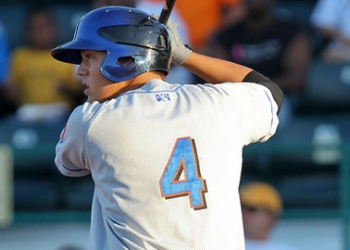
One year ago, Wilmer Flores was on the brink of irrelevancy. He had played 200 games in High-a Port St. Lucie, and hadn’t put up stellar numbers. His 2011 season was one with many ups and downs, and the statistics didn’t look pretty in the end. While he managed to hit a respectable .269 in 559 plate appearances, his on-base percentage was .309 – the second lowest mark of his minor league career. He had signed out of Venezuela as a 16 year-old in 2008 with very high expectations. He was supposed to become a hitting machine, and someone who could eventually become an elite power hitter. In his first season, playing in Kingsport, Brooklyn, and Savannah, he had a .180 ISO, and it looked as if the power was developing early. However, after that, the home runs disappeared and in 2011, he hit a low point, hitting only nine home runs in over 130 games for St. Lucie. His prospect status was in jeopardy. He fell out of the top 15 on many Mets prospect rankings. People started to wonder – what happened? That all changed this season.
Flores broke camp with St. Lucie for the second year in a row, but immediately started hitting the ball much better. He started hitting for power again, slugging ten home runs in 64 games. He had an excellent first half with St. Lucie, batting .289 with a .799 OPS, all capped off by an FSL All-Star Game MVP Award.
He was then called up to Binghamton, where he had a hard time adjusting in his first few weeks. After his adjustment period, he took off again, and hit even better than he did in St. Lucie. Flores continued to hit home runs, slugging eight in 66 games in the Eastern League. He also hit well over .300 for the first time since 2008. His walk rate rose to 7.3%, still below average, but almost a career-high for Flores, and his strikeout rate to its lowest point (10.9%) since he was in Kingsport as a 16 year-old. Between the two leagues, Flores finished with an even .300 batting average, a .827 OPS, 18 home runs, and 30 doubles in 493 at-bats.
What else is there to love about Wilmer Flores? He’s still just 21 years old. He still has plenty of time to get better. The only question mark left with Flores is his defense. He played second base and third base in the minors last year, after posting a dreadful .959 fielding percentage in his career as a shortstop. Flores is big, which may make it difficult for him to be a middle infielder. However, if the Mets want to keep him around, that’s where he may stay because it doesn’t look like Ike Davis or David Wright are going anywhere. If the Mets staff can get him to a point at second base where he is average or slightly below average, he will make up for his sub-par defense with production at the plate.
2013 Outlook: The Mets will not want to rush him (that has hurt him in the past), but Flores got a lot of playing time in the Venezuelan Winter League (in which he played well), so you could see him begin the season with Las Vegas. He isn’t too far off, and could get a cup of coffee at the end of September this year before making his real debut sometime in 2014.
4. Michael Fulmer, RHP
Height: 6’3″
Weight: 200
Throws/Bats: R/R
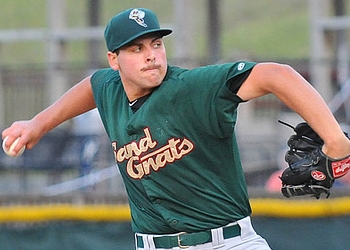
19 year-old Michael Fulmer has quietly become one of the Mets’ top pitching prospects. While most of the attention has gone to Matt Harvey, Zack Wheeler, and Noah Syndergaard, Fulmer is looking like he could be a fixture in the Met rotation as well.
Fulmer was selected by the Mets 44th overall in the 2011 MLB Draft out of Deer Creek High School in Oklahoma. Originally slated to go to the University of Arkansas, the Mets took a risk drafting him, but he eventually signed with them for just under $1 million. He was only able to pitch in four games with the GCL team in 2011 before the season ended.
Fulmer was thrust into the world of professional baseball this year, starting the season with the long-season Sand Gnats of the South Atlantic League. The fifth-youngest pitcher in the league, Fulmer was at a bit of a disadvantage facing hitters older than him, but he still had major success. Armed with a mid-90s fastball to go along with a quality curveball and developing changeup, Fulmer made 21 starts, pitching a total of 108.1 innings. He posted a 2.74 ERA and struck out 8.4 batters per nine, while walking only 3.2, very good for a pitcher right out of high school.
Scouts have been very impressed with Fulmer’s stamina and ability to go deep into games. He has the physical ability to have success at the higher levels.
It’s still very, very early to project what Fulmer could be. He’s still developing, but all signs point towards him becoming a productive starting pitcher.
2013 Outlook: Fulmer will follow the traditional track, and will pitch for St. Lucie, probably for the whole season. He will make his debut sometime in 2015 if he stays healthy.
3. Noah Syndergaard, RHP
Height: 6’5″
Weight: 200
Throws/Bats: R/L
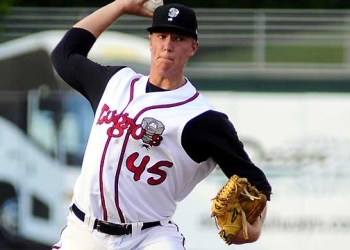
When the Mets traded R.A. Dickey to Toronto, most of the attention went to a certain catcher the Mets got in return. But the Mets acquired another notable player in the trade, a pitcher who has been nothing but dominant in his three-year minor league career: Noah Syndergaard.
Syndergaard, 20, looks much more refined than most pitchers his age. He has much better command than Zack Wheeler had at that age (and maybe even better control than Wheeler right now), walking just 2.7 batters per nine this past season in the Midwest League, which is on the same level as the South Atlantic League. Since coming to the Mets, many writers and scouts have compared him to Zack Wheeler. Syndergaard actually pitched much better this season in A-ball than Wheeler did, as you can see below:
Syndergaard is often compared to Wheeler from a dominance standpoint, but they are two much different pitchers. Syndergaard throws two fastballs. One is a high-90s four-seam and the other is a sinker. Syndergaard does not possess a good secondary pitch, while Wheeler has a very good one.
Overall, it’s tough to compare Syndergaard to Wheeler because they are at completely different stages. Wheeler is knocking at the door to the big league club while Syndergaard probably has two to three years in the minors left before he debuts. However, it’s great to see such success so soon, and I’m hopeful that the Mets will put Syndergaard in a situation where he can develop his secondary pitches because if he does, he could be a very dominant pitcher.
2013 Outlook: Syndergaard pitched the entire season for a long-season Low-A team, so the next logical step for him is St. Lucie. As of right now, I would project him to make his MLB debut in 2015.
2. Travis d’Arnaud, C
Height: 6’2″
Weight: 195
Throws/Bats: R/R

There is a reason why in the negotiations for R.A. Dickey, Sandy Alderson held out for Travis d’Arnaud. He is a game-changer, and one of the few players in the minor leagues that can make trading away the reigning Cy Young Award winner worthwhile. d’Arnaud is of a rare breed of catchers: he can hit for power, average, and is decent with the glove.
A former first-round pick, d’Arnaud didn’t put all those tools together until two years ago, when he had a breakthrough season in Double-A New Hampshire. He had already been a highly-regarded prospect, but he became arguably the most promising catching prospect in the game after his fantastic 2011 season, in which he hit 21 home runs with a slash line of .311/.371/.542.
In 2012, d’Arnaud continued to rake with the bat, this time in Triple-A Las Vegas, where he hit 16 home runs in 67 games. Hitting numbers are inflated by the hitter-friendly Cashman Field in Las Vegas, but d’Arnaud actually hit slightly in away games. The numbers are there. The power is there. d’Arnaud was on track to make his MLB debut in the second half of the season, but had his year abruptly cut short when, in July, he tore his PCL.
d’Arnaud has earned the praise of scouts around the country. Before last season’s excellent performance, Baseball America had him listed as 17th in their overall prospect rankings, tops among catchers. Here’s what they had to say about him:
“He’s a rare catching prospect that projects to hit in the middle of a lineup. He is an above-average hitter who should hit for at least average power. He doesn’t walk much but makes consistent hard contact, getting hits even when his timing is off or he gets off balance. He has the bat speed and strength to hit plenty of homers and lets his power come naturally, employing a short stroke and all-fields approach.”
Power at the catching position is certainly a valuable commodity that very few catchers possess. d’Arnaud seems to have that rare skill and while he is not expected to be a Mike Piazza-type, his minor league power numbers match up well with Piazza’s, meaning d’Arnaud’s power is legit:
At minimum, d’Arnaud looks to be a serviceable MLB catcher, but he can be so much more than that. He has the tools to be a dynamic, all-around catcher who can hit fifth or sixth in the lineup. The only question that remains is health, but he doesn’t seem to have any long-term issues.
2013 Outlook: The Mets are in a situation that many front offices encounter every year. They really believe d’Arnaud is a future star. However, d’Arnaud breaking camp with the big league club in April would mean he becomes a free agent after the 2018 season. If he comes up later, however, he won’t become a free agent until after the 2019 season. It seems like a ridiculous thing to consider now, but down the road it will be something that really matters if d’Arnaud turns out to be the star people think he could be. For that reason, and to test out his injured knee, I would say he spends the first month or so with Las Vegas.
1. Zack Wheeler, RHP
Height: 6’4″
Weight: 185
Throws/Bats: R/L
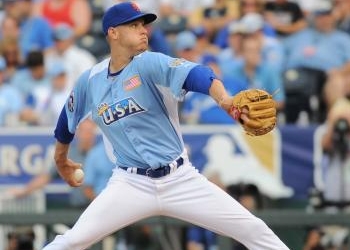
When the Giants picked Zack Wheeler sixth overall in the 2009 MLB Draft, they were taking a player with enormous upside, but not very polished. In his first professional season a year later at age 20, playing in the South Atlantic League, Wheeler showed just that: a high “ceiling” but with work to be done. In his first season, he walked 38 batters over 58.2 innings, and struck out 70. He made 13 starts and appeared in eight out of the bullpen.
In 2011, Wheeler broke camp with San Francisco’s California League (A+) affiliate, San Jose. There, he was once again inconsistent. He pitched well, but couldn’t get over his control problem, and was walking 4.8 batters per nine innings. When the Giants needed a bat for the stretch run in 2011, they were reluctant to part ways with Wheeler because of his potential, but gave him up any way in a desperate move to bolster the offense at the trade deadline. And what looked
Once in the Mets organization, Wheeler’s command started to improve. He finished the year in the tough Florida State League, with Port St. Lucie. He pitched extremely well there, allowing just six runs in 27 innings and walking only five, setting him up for a Double-A debut in 2012.
After a productive ending to 2011, Wheeler picked it right up again, and steamrolled through the Eastern League. He made 19 starts, and had a 3.26 ERA in 116 innings. During his time in Binghamton, he kept his strikeout rate up (9.1 K/9) and his walk rate relatively low (3.3 BB/9), earning him a promotion to Triple-A Buffalo, where he finished the season. He struggled in his six starts at the next level with his command, but in a small sample size (33 innings) like that, it’s not much of a concern right now.
2013 Outlook: Wheeler has “ace” written all over him. With his electric fastball and very good secondary stuff, my guess is he will be very successful in the big leagues. Look for him to debut a few months into this season, unless the Mets are unable to acquire a fifth starter. He needs a bit more seasoning in Triple-A before he gets called up.
What do you think? What do YOUR rankings look like? Also make sure to check out MMO’s OFFICIAL top 25 prospects, but together by the brilliant Satish Ram (“Perseus”) and Sean Kenny.



